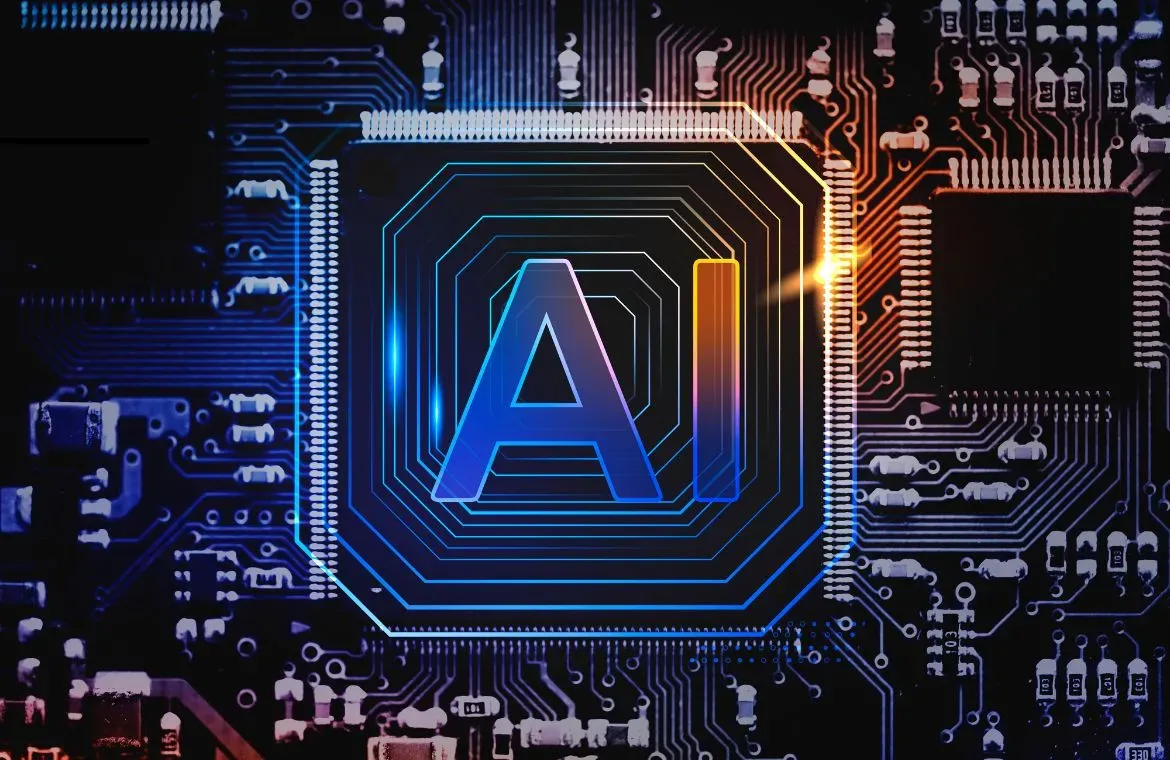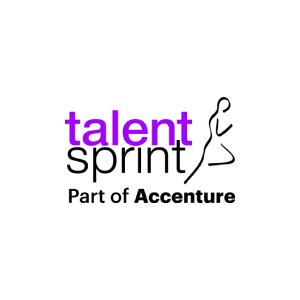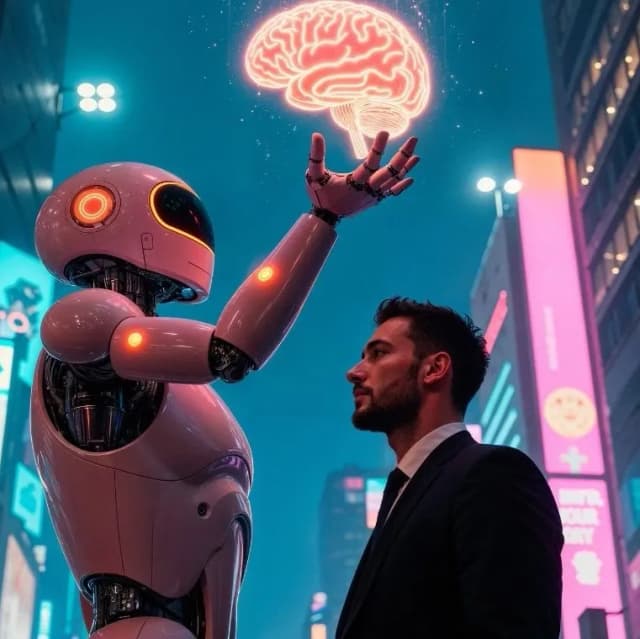All About AI: What Is AI and Why AI Matters

Artificial Intelligence, or AI, is undeniably the future of technology and humanity. From being confined to science fiction or academic discussions to becoming a critical part of businesses, AI has come a long way. Now, the way businesses operate is changing.
In an interview with CBS’s 60 Minutes, Alphabet and Google CEO Sundar Pichai stated, “AI is one of the most profound technologies we are working on today. It’s more profound than fire or electricity.” This sentiment indicates that artificial intelligence is one of the most important technologies that will transform humankind. Just two decades back, this wouldn’t have made any sense; however, witnessing the power and ability of AI, it can be said that AI is going to be the next big thing.
Businesses are using AI to automate various repetitive tasks, which is helping them improve their efficiency. AI is commonly used in multiple business activities, such as chatbots for managing customer conversations and predictive analytics to utilize historical data and prepare for the future. Thus, it doesn’t matter if you prefer or are ignorant about AI; if you want to stay relevant in the business world, you must embrace it.
What is Artificial Intelligence?
In simple terms, AI is a set of technologies that enable computers to mimic human intelligence. However, with the help of AI, business leaders can make better decisions. Why? - First, it comprehensively analyzes data and notices every detail that might escape the human eye. Second, it is free from human errors, so results or analyses are often accurate and reliable.
AI is supposed to augment and empower humans in their work and lives. It is a tool, not a threat. In almost every sphere of life and work, AI injects automation, data power, and the impact of better decisions. This is how it transforms business, cutting costs by a staggering amount and elevating efficiency, agility, and customer intimacy by unprecedented amounts.
As per the reports of Statista, the AI market for 2024 has reached close to ₹15.38 trillion, and this market size is expected to grow at a CAGR of 29.41% for the next 6 years. Thus, the AI market in 2030 would be at ₹72.23 trillion. Interestingly, AI is gaining ubiquity across all the functional areas of a business.
So, British-American computer scientist Professor Andrew NG rightfully says, “Artificial Intelligence is the new electricity.”
With advancements in machine learning (ML), conversational AI, and computer vision, we have entered an age where organizations are architecting converged business and IT process optimizations, predictions, and recommendations. They are, thus, enabling transformative customer and employee experiences.
Despite being of great significance in the business world, Stephen Hawking warned that “AI is supposed to be either the best or the worst thing to happen to humanity.” Here is what is expected of future AI:
- Chatbots and intelligent voice assistants with unique sixth senses give a human touch to conversations
- Robots handling warehouses and manual factory work
- Facial recognition-based law enforcement
- Smoothly cruising self-driving cars
- Augmented Reality (AR)-powered retail shops
- IoT in microwaves and refrigerators
- Self-operating supply chains and whatnot.
However, if machines could do everything, why would we even need humans? For instance, people prefer talking to chatbots and voice assistants instead of socializing and making friends. AI-powered robots may impact jobs in the market. AR-powered retail shops won’t need a human salesperson.
Anyway, it is too soon to say if AI is a boon or a curse.
Types of AI
AI has various stripes:
- Narrow AI, wherein AI can perform specific tasks the way or better than humans can.
- General AI is when machines become human-like, make their own decisions, and learn without human input. It is where AI transcends logic and enters emotions.
- Finally, there is the realm of superintelligence, often referred to as Artificial Superintelligence, in which AI is far ahead of humans in creativity and social skills.
Artificial Intelligence vs Machine Learning vs Deep Learning
Yes, at times, they are used interchangeably, but they are different. AI is about building intelligent programs and machines to solve problems. Its subset is machine learning (ML), which helps systems automatically learn and improve from experience without explicit programming. Here, hand-coding is skipped because the machine is “trained” with large amounts of data and algorithms.
Deep learning (DL) is a subfield of machine learning. The structure of the human brain inspires it and imitates the way humans gain certain types of knowledge. It uses neural networks to analyze various factors with a structure similar to the human neural system. If you wish to further explore this field, consider enrolling in a deep learning course and gaining expertise to shape your AI career.
Evolution of Artificial Intelligence
AI started as a sci-fi dream - a concept in Isaac Asimov’s stories in the 1950s, which now has become our reality. Scientists, mathematicians, and even philosophers wondered whether it was really possible - if machines could think like humans.
It took 6 or 7 decades for AI to really take off. It started with AI-powered virtual assistants like Siri and Alexa. However, nothing shook the world more than Generative AI. Tools like ChatGPT and Gemini redefined the way businesses operate. It helped in automating content creation, software development, and customer service.
When ChatGPT was enjoying all the popularity, Chinese companies heavily invested in creating their own version and succeeded. China’s ERNIE bot built by Baidu, is a perfect competitor to ChatGPT and is here to only intensify the AI race.
So, from sci-fi dreams to business reality, AI has come a long way and is now set to transform industries.
Why Does AI Matter Today?
A quick look at the numbers shows just how fast and broad AI is growing and entering our work and personal lives. The adoption rate of AI is rapidly increasing, and in India, the advancements and opportunities in the AI landscape are becoming more and more visible.
According to NASSCOM’s 2024 AI Enterprise Adoption Index 2.0, around 87% of companies are in the middle stage of AI adoption in India, and in 3 to 4 years, India’s AI market is expected to grow at a CAGR of 25-35%.
You must be thinking about the reason behind the increased adoption of AI and why it matters so much. Here’s the reason:
- Boosting Efficiency: AI can automate repetitive tasks, giving employees more time to focus on critical tasks and improving efficiency.
- Better Insights: AI enables business leaders and entrepreneurs to analyze data quickly and gain real-time insights. These insights are crucial for data-driven decisions and the long-term success of businesses.
- Improved Accessibility: AI has made technology more accessible. For instance, AI-powered voice assistants have become accessible to everyone, including people with disabilities, children, older people, illiterates, etc.
Furthermore, in cognitive domains, AI is proving its worth by automating tasks that require high precision and efficiency. AI systems now seamlessly handle activities such as tagging, clustering, categorization, and hypothesis generation. Additionally, AI excels in alerting, filtering, navigation, and visualization, offering real-time insights and reducing human error. These advancements make data-driven decisions faster and more reliable across industries.
Some key industries impacted by AI are healthcare, banking, financial services, transportation, and many more.
AI in Healthcare
Monumental changes can be seen in the healthcare industry due to AI, which is improving overall healthcare outcomes. Here are some applications of AI in healthcare:
- Robot-assisted surgeries
- AI to measure medical dosage and avoid dosage errors
- Virtual nursing assistants
- AI-powered hospital workflow management
Furthermore, AI’s power to analyze real-time data makes it possible for healthcare professionals to identify potential diseases and disorders. Stay ahead in this revolution by enrolling in an AI in Healthcare course.
Transforming BFSI
AI is also transforming the Banking, Financial Services, and Insurance industries, as its integration has helped to improve overall efficiency and industry innovation. The following are the benefits of AI in BFSI:
- Improved risk assessment
- Investment and portfolio management
- Financial analysis
At its core, AI is about empowering human intelligence with machine precision to achieve previously unattainable results. By seamlessly integrating into critical sectors like healthcare, BFSI, and transportation, AI enhances human capabilities, making processes faster, safer, and more efficient. This synergy between humans and machines is laying the foundation for a brighter, more connected future in finance. If you wish to explore more, you can consider the IIM Calcutta Fintech Course.
Goals of Artificial Intelligence
The key goal of AI is to ease the user's job. In a business landscape, the purpose behind using AI may vary from user to user. For a CEO, integrating AI can increase ROI; similarly, the purpose behind supporting AI integration will be different for the business regulator or customer.
In this context, AI has different goals for different stakeholders. Companies gain value from AI implementation, and five significant areas of these values are discussed below:
- Increased Productivity: AI is designed to mimic human intelligence. Thus, it can automate cognitive and repetitive tasks, helping to carry out tasks faster and improve organizational productivity.
- Increased Customer Satisfaction: AI-powered chatbots reduce the time customers spend in customer support queues and offer timely resolutions to their queries, significantly improving customer satisfaction. Moreover, AI tools can analyze customer data and understand their preferences, enabling businesses to personalize at scale. For instance, streamlining platforms utilize AI algorithms to understand customer preferences and create personalized playlists for them. Furthermore, AI can also be used for sentiment analysis. AI tools can analyze customer tones in conversations on social media or digital platforms, and based on the insights from sentiment analysis, the required steps can be taken.
- Improved Employee Engagement: AI can help automate tasks; however, AI integration helps employees continue using advanced technologies and upskill in AI skills. Thus, it is associated with improved employee satisfaction. Furthermore, AI helps employees reduce their work pressure and focus on critical tasks, therefore making them more efficient at work.
- Enhanced Profitability: AI is associated with improved efficiency and productivity. It can help businesses avoid dependence on various software and resources, reducing expenditures while increasing output. Thus, it can enhance organizational profitability.
- Increased Innovation: Generative AI is a subset of AI that can help boost innovation within the organization. It can be used for prototyping, product design, and content creation. Generative AI can generate innovative, novel results occasionally without feeling overwhelmed or tired.
These are some AI goals that are common across organizations. However, different organizations may have different AI goals. AI goals are challenging to define and measure, so an organization needs to have a good understanding of what it is looking for and how it will achieve that. It is better to express AI goals as well-posed questions and hypotheses about a specific and intended benefit or outcome.
According to PwC’s 2024 survey, having the right AI goals is important, as the company’s AI strategy can either put them ahead or make it hard for them to ever catch up with the competitors. Thus, determining the accuracy of AI goals is essential. Here is how an organization can set AI goals:
- Understand organizational AI maturity level
- Define long-term objectives and align AI with those objectives
- Invest strategically in AI technology and talent development
- Assess competitors’ strategies
Wrapping Up…
Artificial intelligence is undeniably the next wave of technological transformation, reshaping businesses, industries, and society. From enhanced automation to groundbreaking innovations, AI’s impact is far-reaching. As this technology continues to evolve, the need for professionals skilled in it will surge.
So, if you, too, wish to thrive in the ever-evolving technological landscape, acquire the required skills and knowledge to work with AI.
Explore our comprehensive AI courses to gain expertise in this transformative field.

TalentSprint
TalentSprint is a leading deep-tech education company. It partners with esteemed academic institutions and global corporations to offer advanced learning programs in deep-tech, management, and emerging technologies. Known for its high-impact programs co-created with think tanks and experts, TalentSprint blends academic expertise with practical industry experience.



